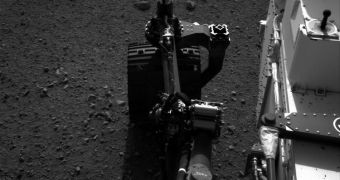Curiosity managed to move its wheels for the first time since landing on the surface of the Red Planet, more than two weeks ago. The maneuver was carried out yesterday, August 21, and its ultimate goal is to see whether or not all of the robot's wheels can spin and turn properly.
At the same time, the Mars Science Laboratory (MSL) investigated the weather at its location, in anticipation of its first drive. The $2.5 billion machine also photographed the soil at its locations, analyzing some of its properties.
The rover features a Spanish-built weather station instrument, capable of checking ground and air level temperatures, air pressure, wind speed, and a host of other variables. These measurements are taken once every hour, so scientists have access to accurate, up-to-date Martian weather data.
Over the past two weeks, the instrument has already collected a series of data which enabled experts to determine that air temperatures on the surface swing from -2 to -75 degrees Celsius (28 to -103ºF), between day and night.
Between afternoon and pre-dawn morning, ground temperatures may vary from 3 to -91ºC (37 to -132ºF), an even greater difference. “We will learn about changes from day to day and season to season,” scientist Javier Gómez-Elvira explains.
The expert, who is based at the Centro de Astrobiología in Madrid, Spain, holds an appointment as the principal investigator of the weather sensor suite known as the Rover Environmental Monitoring Station (REMS) instrument.
Spanish researchers say that one of the two sets of REMS wind sensors is currently nonoperational. The exact reasons why this happens are unknown, but it could be that a malfunction occurred, or that the devices were damaged during landing.
“One possibility is that pebbles lofted during the landing hit the delicate circuit boards on one of the two REMS booms. We will have to be more clever about using the remaining wind sensor to get wind speed and direction,” says JPL expert Ashwin Vasavada, the deputy project scientist for Curiosity.
Another instrument that began operations is the Dynamic Albedo of Neutrons (DAN), a tool for discovering water that may be bound in minerals within the first meter (3 feet) of Martian soil.
“Curiosity has begun shooting neutrons into the ground. We measure the amount of hydrogen in the soil by observing how the neutrons are scattered, and hydrogen on Mars is an indicator of water,” says DAN principal investigator, Igor Mitrofanov, from the Space Research Institute in Moscow, Russia.

 14 DAY TRIAL //
14 DAY TRIAL //